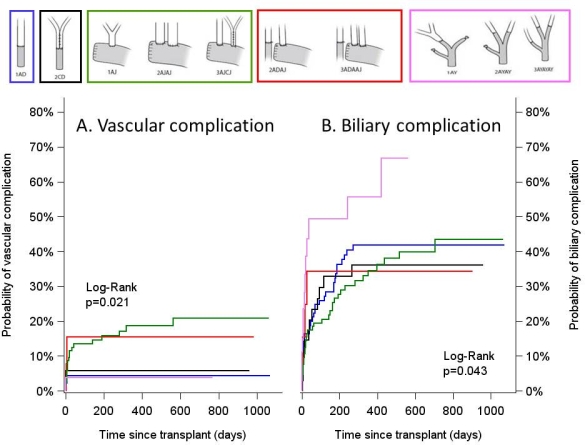Impact of Anatomic Variation and Reconstructive Technique on Complications Following Living Liver Donor Transplantation – A Report from the A2ALL Consortium
T. Baker,1 M. Zimmerman,2 B. Samstein,3 E. Pomfret,4 J. Pomposelli,4 C. Berg,5 N. Goodrich,6 B. Gillespie,7 J. Emond.3
1Northwestern University, Chicago
2University of Colorado, Denver
3Columbia University, New York
4Lahey Clinic, Burlington
5Duke University, Durham
6Arbor Research, Ann Arbor
7University of Michigan, Ann Arbor.
Meeting: 2015 American Transplant Congress
Abstract number: 398
Keywords: Hepatic artery, Liver transplantation, Living-related liver donors, Surgical complications
Session Information
Session Name: Concurrent Session: Liver: Living Donors and Partial Grafts
Session Type: Concurrent Session
Date: Tuesday, May 5, 2015
Session Time: 2:15pm-3:45pm
 Presentation Time: 2:15pm-2:27pm
Presentation Time: 2:15pm-2:27pm
Location: Room 115-AB
Introduction: Living donor liver transplantation [LDLT] is a technically demanding endeavor that requires command of the complex anatomy of partial liver grafts. The aim of this study was to examine the influence of anatomic variation and reconstruction technique on surgical outcomes and graft survival in the Adult to Adult LDLT cohort study [A2ALL].
Methods: Data were analyzed from 272 adult LDLT recipients and included details on anatomic characteristics and types of intraoperative biliary reconstruction performed. The associations between reconstruction technique and time to first biliary (leak, stricture or biloma) [BC] or vascular (hepatic artery thrombosis [HAT] or portal vein thrombosis [PVT]) [VC] complications were estimated using Kaplan-Meier curves and tested with log-rank tests.
Results: Median follow-up time was 1.1years. Significant associations were found between the type of biliary reconstruction and the incidence of VC (p=0.02) and BC (p=0.04). Recipients with Roux-en-Y hepatico-jejunostomy had the highest probability of VC (Figure 1A). Recipients with biliary reconstruction involving the use of high biliary radicals on the recipient duct had the highest likelihood of developing BC by 1 year (56%) compared to duct-duct (42%) (p=0.02) (Figure 1B).
Conclusion: The varied surgical approaches in the 9 A2ALL centers offer a novel opportunity to compare disparate approaches in LDLT. Use of the recipient duct above the bifurcation is associated with more BC, while roux reconstruction was associated with VC. These data should inform further improvements in LDLT reconstructions in the face of anatomic variants to decrease the still high incidence of technical complications associated with LDLT.

To cite this abstract in AMA style:
Baker T, Zimmerman M, Samstein B, Pomfret E, Pomposelli J, Berg C, Goodrich N, Gillespie B, Emond J. Impact of Anatomic Variation and Reconstructive Technique on Complications Following Living Liver Donor Transplantation – A Report from the A2ALL Consortium [abstract]. Am J Transplant. 2015; 15 (suppl 3). https://atcmeetingabstracts.com/abstract/impact-of-anatomic-variation-and-reconstructive-technique-on-complications-following-living-liver-donor-transplantation-a-report-from-the-a2all-consortium/. Accessed December 20, 2025.« Back to 2015 American Transplant Congress
